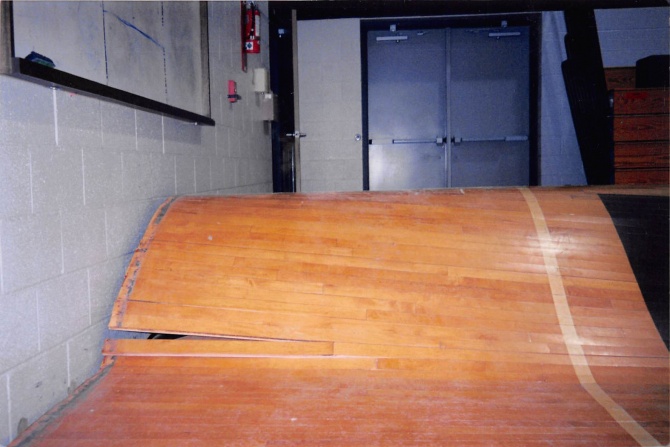
This is what can happen when water and wood floors mix.
Wood expands and contracts based on the amount of moisture in the air around it. If excessive moisture gets into your wood floor, it will cause your floor to either cup or crown. Cupping occurs when individual boards bend upward at the edges because they have run out of space to expand horizontally due to moisture intake (a U shape). Crowning is the opposite - the center of the board bends upward, making the middle higher than the edges (an upside down U shape).
Even a small amount of water can cause damage to your wood gym floor, so be sure to call a certified MFMA installer as soon as the damage occurs. The sooner repairs start, the less time the water has to spread to other areas of your floor - and the sooner repairs begin, the smaller the chance of developing mold. That's right, MOLD (another four letter word in this office).
How to Repair a Water Damaged Wood Floor
There are several ways that maintenance companies, janitorial companies, and random flooring guys will tell you to fix a floor with water damage. The most common solution we hear about is to dehumidify the floor, or dry it out. While this sounds like a good idea in theory, in reality it doesn't work. Once the water is in the wood, it will never return to normal. If there is excessive water on and/or around the floor, we recommend using a Shop Vac to remove the water, and then using fans or blowers to dry the concrete. Dehumidifying is necessary to dry the concrete, but it will not help the wood.
The video below shows a gym we recently replaced due to water damage. In this case, the water was vacuumed out of the room and fans were used to dry the concrete once the floor was torn out. No other option would have saved this floor, simply because of the massive amount of water on it.
nother solution we hear about is to immediately sand the water damaged wood in order to remove the polyurethane finish on top and allow the water to be released through the top of the wood. This would be a viable solution if wood were not a living organism that changes with humidity and moisture levels. But alas, that is not the case.

You see, when you sand cupped wood, it will appear to be even and flat when the sanding is complete. However, when the wood finally dries back out, you will have sanded the ends that were cupped lower than the center of the wood (which was not elevated at the time of sanding). Therefore, when the wood finally dries out, it will appear to have crowned.
The Solution
In our 19 years of experience working with basketball floors, the solution with the most long-term success when repairing a water-damaged wood floor is to tear out the affected area and replace it. In some cases, this requires the entire floor to be replaced. If it is a smaller area of the floor that is affected, we will replace that area and recommend sanding the entire floor. If those measures are taken, no one will be able to tell your floor was damaged or patched when the work is complete. It also gives you the opportunity to redesign your floor layout - maybe add a new logo, or some letters. Have fun with it!
McKenzie High School (pictured below) needed patching, and they used that as an opportunity to redesign their basketball court. As you can see, the results were amazing.
